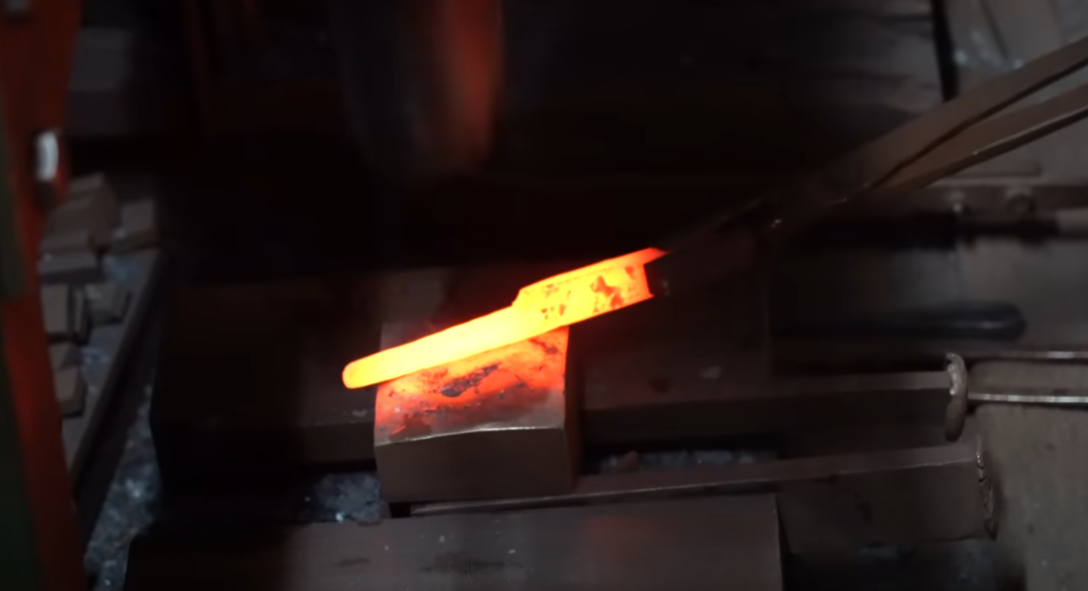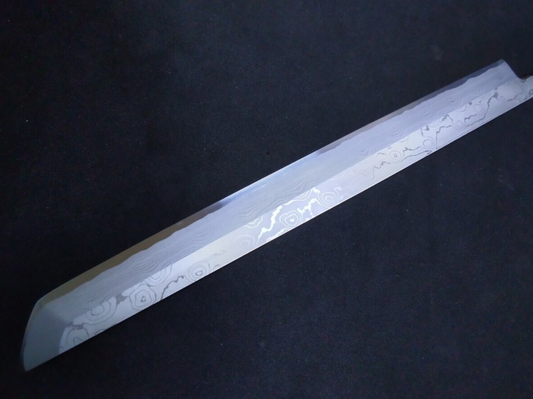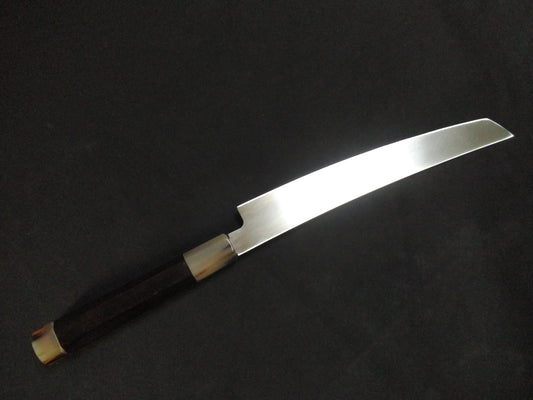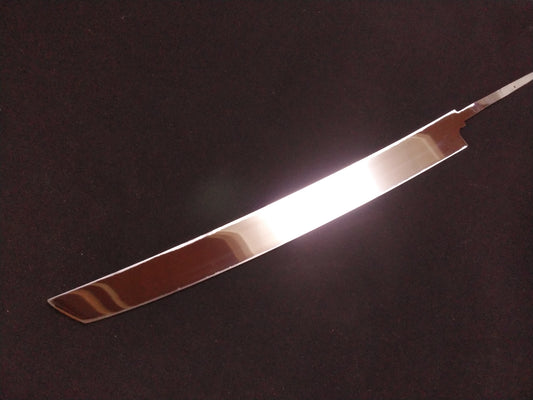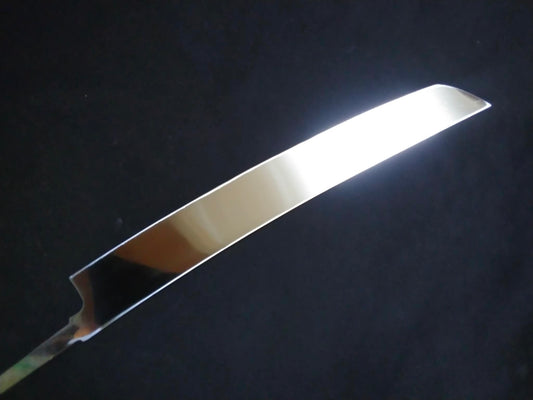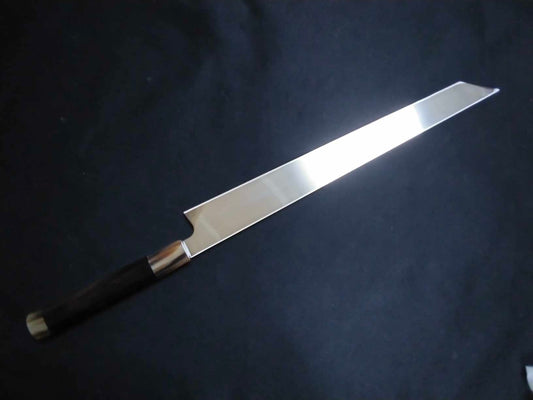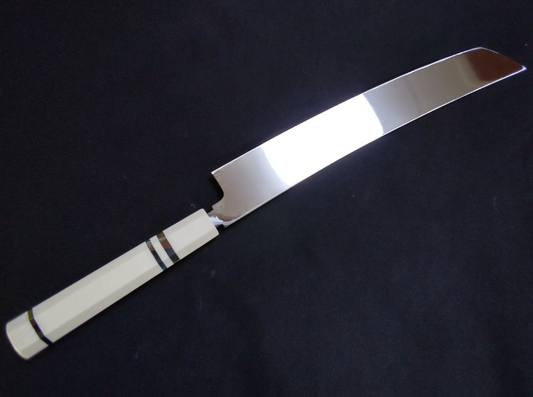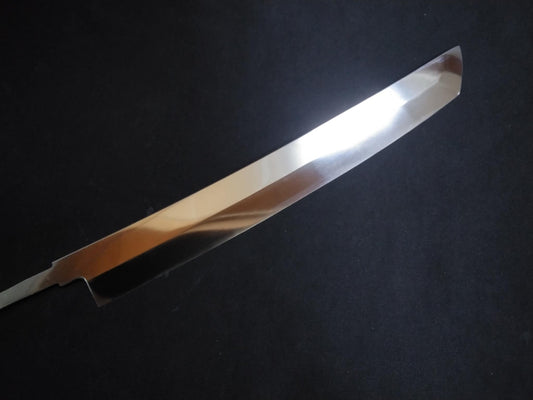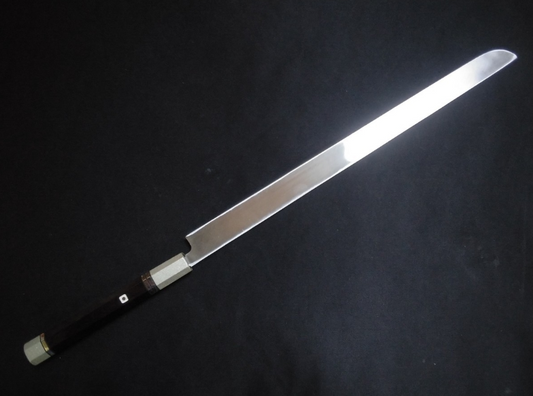
Yanagiba (Sakimaru)
-
-
When choosing a traditional Japanese sashimi knife, the Yanagiba and its notable variation, the Sakimaru, are among the most widely used. Each offers unique features tailored to different slicing techniques and user preferences. Understanding these distinctions is key to selecting a knife that suits your culinary goals.
-
Yanagiba
-

The Yanagiba is the most common type of sashimi knife, known for its ease of use. The name comes from its blade shape, which resembles the leaves of a willow or iris leaf. The defining feature of the Yanagiba is the smooth curve from the heel to the tip, which makes it ideal for pull cuts, allowing for clean, beautiful slices of sashimi. Additionally, it is easy to sharpen, making it a favorite among both beginners and professionals.
-
Yanagiba (Sakimaru)
-

The Sakimaru is characterized by its rounded tip. Like the Kiritsuke, it is made with a thicker blade, giving it a heavier weight. This design makes it less suitable for precise tasks that rely on the tip of the blade. Using the tip for delicate cuts can be cumbersome, and the blade's shape is more difficult to maintain as sharpening tends to lower the tip over time. This results in a challenge to keep the blade's shape consistent.
-
Price Differences and Selection
Compared to the Yanagiba, the Sakimaru is generally more expensive, even when the blade length is the same. This is because it requires a larger piece of steel to be shaped down in order to achieve its distinctive design, which increases material costs. When selecting a knife, it's important to consider your specific needs and budget carefully to choose the most suitable one.
Yanagiba(Sakimaru) Japanese Knife Collection
-
Wihte Steel #2 Damascus Yanagiba (Sakimaru) 300mm- Mirror Polished Blur Finish
Regular price $546.00 CADRegular priceUnit price / per -
Super Steel (Honyaki) Yanagiba(Sakimaru) 240mm-Mirror Polished(one side)
Regular price $584.00 CADRegular priceUnit price / per$0.00 CADSale price $584.00 CADSold out -
Super Steel (Honyaki) Yanagiba(Sakimaru) 270mm-Mirror Polished(both sides)
Regular price $679.00 CADRegular priceUnit price / per$0.00 CADSale price $679.00 CAD -
Ginsan Damascus Yanagiba(Sakimaru) 300mm -Mirror Polished(both sides)
Regular price $700.00 CADRegular priceUnit price / per$0.00 CADSale price $700.00 CAD -
Super Steel (Honyaki) Yanagiba(Sakimaru) 330mm-Mirror Polished(both sides)
Regular price $812.00 CADRegular priceUnit price / per$0.00 CADSale price $812.00 CAD -
Ginsan (Honyaki) Yanagiba(Sakimaru) 300mm -Mirror Polished(both sides)
Regular price $920.00 CADRegular priceUnit price / per -
Ginsan Damascus Yanagiba(Sakimaru) 400mm-Mirror Polished(both sides)
Regular price From $936.00 CADRegular priceUnit price / per$0.00 CADSale price From $936.00 CADSold out -
Ginsan (Honyaki) Yanagiba (Sakimaru) 270mm -Mirror Polished(both sides)
Regular price $960.00 CADRegular priceUnit price / per$685.00 CADSale price $960.00 CAD -
Super Steel (Honyaki) Yanagiba(Sakimaru) 360mm-Mirror Polished(both sides)
Regular price From $965.00 CADRegular priceUnit price / per$0.00 CADSale price From $965.00 CAD -
White Steel #2 (Honyaki-Mizuyaki) Yanagiba (Sakimaru) 300mm-Mirror Polished(one side)
Regular price $1,000.00 CADRegular priceUnit price / per$0.00 CADSale price $1,000.00 CAD -
White Steel #2 (Honyaki) Yanagiba (Sakimaru) 330mm-Mirror Polished(one side)
Regular price $1,200.00 CADRegular priceUnit price / per$0.00 CADSale price $1,200.00 CADSold out -
White Steel #2 (Honyaki-Mizuyaki) Yanagiba (Sakimaru) 360mm-Mirror Polished(one side)
Regular price $1,300.00 CADRegular priceUnit price / per -
Blue Steel #2 (Honyaki-Mizuyaki) Yanagiba (Sakimaru) 360mm -Mirror Polished(one side)
Regular price $1,590.00 CADRegular priceUnit price / per -
ZDP189 Yanagiba (Sakimaru) 420mm-Mirror Polished(both sides)
Regular price $2,031.00 CADRegular priceUnit price / per$0.00 CADSale price $2,031.00 CAD
KIREAJI's Three Promises to You
-

1. Exceptional Japanese Knives
We offerOur knives, crafted by Sakai City's master artisans, combine traditional techniques with carefully selected materials, delivering unrivaled sharpness and durability. knives crafted by craftsmen from Sakai City.
-

2. For a Lifetime of Use
At KIREAJI, we see knives as lifelong companions. Each knife comes with a free saya, and we offer Honbazuke hand-sharpening by Shiroyama Knife Workshop in Sakai City.
-

3. Supporting the Joy of Continued Use
KIREAJI knives are made to grow with you. That’s why we provide trusted after-sales care (fee-based) .
Why Is the Tip of the Yanagiba (Sakimaru) Knife Rounded? — The Aesthetic Evolution Born from the Spirit of the Katana and the Grace of the Chef
-
Every detail of a Japanese knife has meaning.
In particular, the Yanagiba, a traditional Japanese knife for slicing sashimi, is a tool where every motion and touch can affect the quality of the dish. In recent years, a variation known as the Yanagiba (Sakimaru)—a Yanagiba with a rounded tip—has been gaining quiet popularity among professionals.
This seemingly minor change—the rounded tip—carries with it a deep blend of beauty, functionality, safety, and cultural reverence.
-
1. Aesthetic Evolution Inspired by the Japanese Katana
The most distinct feature of the Yanagiba (Sakimaru) is its gracefully rounded tip.
This design resembles the kissaki (tip) of a traditional Japanese katana and embodies the spirit of Japanese aesthetic tradition.In modern culinary spaces—especially open kitchens where chefs perform in front of guests—the presence of the knife becomes part of the dining experience. The elegance of movement, the subtle gleam of steel, the rhythm of slicing—these things matter.The Yanagiba (Sakimaru), with its poised and sword-like silhouette, is a knife made not just to cut, but to “perform” as a visual extension of the chef’s philosophy. It’s more than a tool—it’s a quiet yet powerful statement.
-

2. Why Round Is Better — A Functional Upgrade
But this rounded tip isn’t just about looks.
It also brings practical advantages to professional use.For example, when preparing delicate sashimi, a pointed tip can sometimes pierce too deeply or enter the flesh at the wrong angle. This can lead to minor tearing or a murky cut surface, even in the hands of a skilled chef.
The beauty of the rounded tip is in how it glides into the fish without resistance. In the precise "pull-cut" technique used with Yanagiba knives, the rounded end reduces unwanted pressure, allowing clean, glossy cuts that maintain the integrity of the fish.
This is especially important for ultra-delicate dishes like fugu sashimi, where precision down to the millimeter defines the craft.
-
3. Safety and Rhythm — Designed for the Demands of Professionals
Another key benefit of the rounded tip is enhanced safety.
Due to the Yanagiba’s long and slender shape, its pointed tip has always been vulnerable—easy to chip, drop, or accidentally stab the cutting board or even a hand.By rounding the tip, the contact with the cutting surface becomes gentler, creating a buffer of safety and mental ease during high-pressure tasks.
In other words, the knife begins to adapt to the chef—not the other way around.This not only prevents injuries, but also helps maintain focus and flow, making it a highly appreciated feature in fast-paced professional kitchens.
-

4. Tradition Meets Innovation — A Crossbreed of East and East
Interestingly, the Yanagiba (Sakimaru) represents a hybrid of two traditional Japanese knives:
- The Kansai-style Yanagiba, known for its long, graceful slicing.
- And the Kanto-style Takohiki, with its straighter edge and rectangular tip for better handling.
The rounded tip draws from both, offering the visual elegance of the Yanagiba and the versatility of the Takohiki. It’s a harmonious evolution born from regional techniques and modern needs.
This fusion of past and present makes the Yanagiba (Sakimaru) not only a functional upgrade, but also a symbol of how Japanese cutlery continues to evolve in a global culinary context.
-
5. The Chef’s Identity in Steel
To a Japanese chef, a knife is not just a tool.
It is an extension of their skill, spirit, and story—a silent yet eloquent face of their craft.The Yanagiba (Sakimaru) blends tradition and innovation, form and function, elegance and utility. It is a knife that tells a story, not just about food, but about the philosophy behind it.
That’s why it’s gaining attention not only in Japan, but also among discerning chefs around the world.
-
Conclusion
Why is the tip of the Yanagiba knife rounded?
Because this small change embodies a big idea: to unite beauty, performance, safety, and cultural identity in one refined form.In those few millimeters of curvature, we find the essence of Japanese craftsmanship—a culture that breathes life and meaning into even the smallest design details.
FAQ About Yanagiba(Sakimaru)

What is a Yanagiba (Sakimaru)?
The Yanagiba (Sakimaru) is a traditional Japanese slicing knife designed specifically for cutting sashimi with minimal damage to the fish’s delicate fibers. While it shares the same basic purpose as the standard Yanagiba, the Sakimaru version is distinguished by its elegantly curved, rounded tip, which resembles the kissaki (tip) of a Japanese katana. It’s favored by sushi chefs and high-end culinary professionals for its performance and aesthetic appeal.
Why is it called "Sakimaru"?
The name "Sakimaru" literally means “rounded tip”. This specific tip shape offers both visual elegance and practical advantages:
- Graceful appearance:
The curved tip evokes the elegance of a traditional Japanese sword, making it ideal for open-kitchen or sushi counter settings. - Smooth slicing:
The round tip reduces resistance during slicing, allowing for ultra-smooth, clean cuts that preserve the texture and flavor of delicate fish. - Improved safety:
Compared to sharply pointed tips, the rounded tip helps minimize accidental piercing or injuries, making it safer for busy kitchens.
What’s the difference between a standard Yanagiba and a Yanagiba (Sakimaru)?
The primary difference lies in the shape of the tip and the handling characteristics that come with it.
- Tip shape:
Yanagiba: Sharply pointed tip, straight and narrow.
Yanagiba (Sakimaru): Elegantly rounded tip with a curved silhouette. - Handling:
Yanagiba: Excellent for straight, precise cuts.
Yanagiba (Sakimaru): Provides fluid motion and control, especially during long slicing pulls. - Visual appeal:
Yanagiba: Sleek and professional.
Yanagiba (Sakimaru):More refined and commanding, ideal for performance and presentation.
In short, the Yanagiba (Sakimaru) is a refined evolution of the traditional model—adding a sense of beauty and control while retaining slicing performance.
What are the advantages of the rounded tip?
The rounded tip of the Yanagiba (Sakimaru) offers several key advantages:
Enhanced slicing performance: The curvature allows the blade to glide through fish with minimal friction, resulting in clean, glossy surfaces ideal for sashimi.
Visual impact: Its sword-like silhouette enhances the drama of presentation and preparation, especially in front of customers.
Precision handling: The round tip allows for fine, delicate tasks, such as decorative cuts or nuanced angle adjustments.
Durability: Compared to sharply pointed tips, the rounded tip is less prone to chipping or cracking upon accidental contact with hard surfaces.
Is the Yanagiba (Sakimaru) suitable for beginners?
Yes — with the right guidance and care, even beginners can use it effectively.
However, there are a few points to consider:
Single-bevel blade requires practice: Since the Yanagiba is single-beveled, beginners may need time to get used to slicing straight.
Proper slicing technique is key:: Rather than pressing down, users must learn to perform a smooth pull-cut (hikikiri) from heel to tip.
Rounded tip adds safety: The curved tip makes the blade less likely to cause accidental stabs or injuries, which is reassuring for newer users.
As a starting point, a 270mm Yanagiba (Sakimaru) is often recommended for its balance between control and cutting length.

The Origin of Craftsmanship
-
The Essence of Yanagiba Knives: A Fusion of Tradition and Craftsmanship
The Yanagiba knife is an essential tool for preparing sashimi and other delicate dishes. When crafting these knives, every detail, from material selection to the fine honing of the blade, is meticulously attended to with no compromises. Special attention is given to the "ura-suki" (concave back) and the angle of the blade, as even the slightest imperfection can affect its performance. Each knife is carefully honed and adjusted by hand to ensure it achieves an optimal state.
-
Honing a Yanagiba knife isn’t just about achieving sharpness. It’s about striking the perfect balance between "cutting precision" and "smoothness", enabling the blade to effortlessly glide through ingredients while enhancing their natural beauty and flavor. This is why we carefully evaluate both the front and back of the blade throughout the process, making precise adjustments at every step.
-
Above all, our Yanagiba knives are designed with the user’s satisfaction in mind. They are crafted to fit perfectly in the hands of chefs, ensuring comfort even during extended use. Most importantly, our goal is to create a knife that inspires chefs to say, "This knife elevates my dishes to another level." That moment of connection is the greatest reward for us as craftsmen.
-
Each Yanagiba knife is imbued with the passion and dedication of its maker, even in the parts you cannot see. By preserving traditions while embracing new techniques, we strive to continually refine and innovate. We invite you to experience the unparalleled sharpness and beauty of these knives for yourself.
